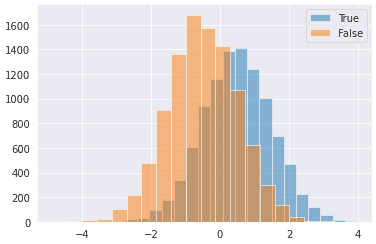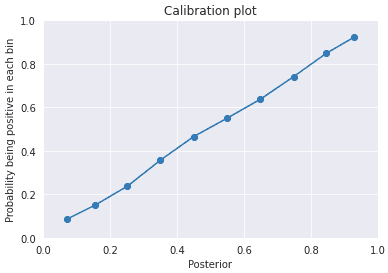On Optimal Threshold for Maximizing F1 Score
May 15, 2021 | 9 min read | 4,465 views
This post attempts to take a deeper look at the F1 score — a popular metric for classification tasks. Based on a paper written by Lipton et al. in 2014 [1], I introduce some interesting properties of F1 with proofs. For instance, if the classifier outputs calibrated scores, the optimal threshold for maximizing F1 is half the optimal F1 score. After that, I confirm the claimed property through experiments, giving visualizations that may help better understand the original paper.
Recap: Definitions
Before diving into the main part, let’s recap some definitions quickly. A confusion matrix represents the counts of true positives, false positives, false negatives, and true negatives.
| Actual Positive | Actual Negative | |
|---|---|---|
| Predicted Positive | TP | FP |
| Predicted Negative | FN | TN |
Precision and recall are defined as below.
F1 score is the harmonic mean of precision and recall:
If you want to consider recall times more important than precision, you could use a generalized version:
which we don’t discuss in this post.
Just like other metrics such as accuracy, precision, and recall, the F1 score is also sensitive to the choice of the threshold. Tuning threshold could be as important as designing the prediction model. Actually, in a recent Kaggle competition, one of the techniques that made difference was the postprocessing part to choose the optimal threshold.
Theory: Optimal Threshold for Maximizing F1 Score
Setups are done, so let’s move on to the main part. We start by simply combining the above definition with the Bayes’ rule.
Lemma 1. By denoting the base rate by , and hence , the entries of the confusion matrix are:
Proof. is defined as:
From the Bayes’ rule, we have
Combining the above two equations, we get
Similar arguments hold for the other three entries.
Now we can derive the optimal decision rule that a classifier should follow.
Theorem 1. To maximize F1, a classifier should predict a sample with score as positive if and only if:
where is the Jaccard index of the optimal classifier.
Proof. Suppose that the decision rule has been fixed for all the region but a paticular region around a point . We want to identify so that we can decide whether a sample with score is positive or negative. For brevity, let’s write:
Let’s say our current decision rule achieves the F1 score:
If we predict the region as positive, that is , our new F1 score is:
On the other hand, if we predict the region as negative, that is , our new F1 score is:
Therefore, we should predict the region as positive if and only if:
By approximating , we have:
Taking the limit results in the claimed theorem.
In a special case, where the model outputs calibrated probabilities (e.g., logistic regression), that is and , the following corollary holds.
Corollary 1. To maximize F1, a classifier should predict a sample with predicted probability as positive if and only if:
where is the F1 score of the optimal classifier.
Proof. From the Bayes’ rule and the definition of calibration,
Incorporating the the above two equations in Theorem 1 gives:
This section is heavily based on [1] with some modifications. For more details, please read the original paper. It discusses the F1 score more deeply with intriguing figures like below.
Experiment
I conducted a simple experiment to confirm the claimed property that the optimal threshold is half of the maximum F1 score.
Using the following libraries,
import numpy as np
import matplotlib.pyplot as plt
import pandas as pd
import seaborn as sns
sns.set_style("darkgrid")
from sklearn.calibration import calibration_curve
from tqdm.notebook import tqdmI generated a balanced dataset of 20,000 samples for binary classification:
n_pos = 10000
n_neg = 10000
df = pd.concat([
pd.DataFrame({
'target': [True]*n_pos,
'feature': np.random.normal(loc=0.5, scale=1.0, size=n_pos)
}),
pd.DataFrame({
'target': [False]*n_neg,
'feature': np.random.normal(loc=-0.5, scale=1.0, size=n_neg)
})
], ignore_index=True)
plt.hist(df.query('target').feature, bins=20, alpha=0.5, label='True')
plt.hist(df.query('not target').feature, bins=20, alpha=0.5, label='False')
plt.legend();Since the true distributions are known in this setting, I calculated the posteriors directly like below (that is, not predicting them). If you predict posteriors, you should check if they are properly calibrated so the condition of Corollary 1 is satisfied. As shown in the figure below, the scores are perfectly calibrated in this case.
def likelihood_gaussian(arr, mu, sigma):
a = - (arr - mu) ** 2 / (2 * sigma ** 2)
return np.exp(a) / ((2 * np.pi) ** 0.5 * sigma)
def posterior(arr, mu_pos, mu_neg, sigma):
p_pos = likelihood_gaussian(arr, mu_pos, sigma)
p_neg = likelihood_gaussian(arr, mu_neg, sigma)
return (0.5 * p_pos) / (0.5 * p_pos + 0.5 * p_neg)
y_prob = posterior(df.feature.values, 0.5, -0.5, 1)
trues, preds = calibration_curve(df.target, y_prob, n_bins=10)
plt.plot(preds, trues, marker='o')
plt.xlabel("Posterior")
plt.ylabel("Probability being positive in each bin")
plt.xlim(([0, 1]))
plt.ylim(([0, 1]))
plt.title("Calibration plot");Now the optimal threshold. I examined every possible threshold while calculating the expected F1 score base on the posteriors, and chose the optimal threshold that gives the maximum score.
def expect_f1(y_prob, thres):
idxs = np.where(y_prob >= thres)[0]
tp = y_prob[idxs].sum()
fp = len(idxs) - tp
idxs = np.where(y_prob < thres)[0]
fn = y_prob[idxs].sum()
return 2*tp / (2*tp + fp + fn)
def optimal_threshold(y_prob):
y_prob = np.sort(y_prob)[::-1]
f1s = [expect_f1(y_prob, p) for p in y_prob]
thres = y_prob[np.argmax(f1s)]
return thres, f1s
thres, f1s = optimal_threshold(y_prob)
print(f"Predicted Optimal Threshold is {thres:.5f} with F1 score {expect_f1(y_prob, thres):.5f}")Predicted Optimal Threshold is 0.35991 with F1 score 0.71965
Yes, the optimal threshold is around half the maximum F1 score!
Finally, I visualized how the expected F1 score changed against different thresholds and how the curve crossed the curve of the sorted posteriors at the optimal threshold point.
tmp = np.sort(y_prob)
f1s = np.array(f1s)
fig = plt.figure(figsize=(12, 6))
ax = fig.add_subplot(1, 2, 1)
ax.plot(tmp, f1s[::-1])
ax.vlines(thres, 0, 1, linestyles="--")
ax.set_xlabel('Threshold')
ax.set_ylabel("F1 score")
ax.set_ylim([0, 1]);
ax = fig.add_subplot(1, 2, 2)
ax.plot(tmp[::-1], label="Predicted probability")
ax.plot(f1s, label='F1')
ax.plot(f1s/2, label='F1/2')
ax.set_xlabel('Index')
ax.legend()
ax.set_ylim([0, 1]);References
[1] Zachary C. Lipton, Charles Elkan, Balakrishnan Naryanaswamy. ”Optimal Thresholding of Classifiers to Maximize F1 Measure”. In ECML PKDD. 2014.
![[object Object]](/static/2d0f4e01d6e61412b3e92139e5695299/e9fba/profile-pic.png)
Written by Shion Honda. If you like this, please share!











